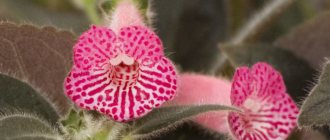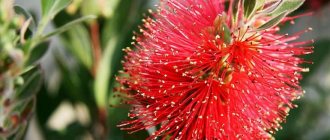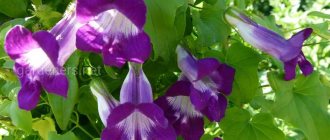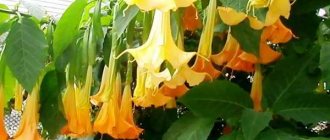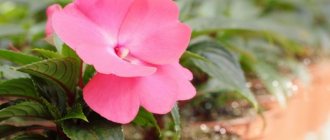Author: Elena N. https://floristics.info/ru/index.php?option=com_contact&view=contact&id=19 Category: Garden plants Published: February 18, 2019Last edits: November 03, 2020
- When to plant
- Rules of care
- Seaside cineraria (cineraria maritima)
In the garden, cineraria is grown as an annual or biennial. In indoor culture, this plant can bloom annually from December to March. There are already about 1300 species of cineraria. Most of them are grown for their flowers, and coastal cineraria is valuable for its either gray or silvery leaves.
Each type of cineraria has its own requirements for soil, conditions and care. From our article you can find out:
- how to sow cineraria for seedlings;
- how to transplant seedlings into pots or open ground;
- how to care for the plant before, during and after flowering;
- how to propagate cineraria.
In addition, you will learn which types of this plant are most often grown in culture.
Planting and caring for cineraria
- Planting: sowing seeds for seedlings in early April, planting seedlings in open ground in mid-May.
- Flowering: from mid-June until frost.
- Lighting: bright light in the morning and partial shade in the afternoon.
- Soil: fertile, well-drained, neutral or slightly alkaline.
- Watering: abundant, regular.
- Fertilizing: 2 times a month with complex mineral fertilizers.
- Reproduction: flowering species - by seed, decorative foliage - by seeds and cuttings.
- Pests: aphids, spider mites.
- Diseases: powdery mildew, rust.
Read more about growing cineraria below.
Cineraria (lat. Cineraria) is the name of the genus of the Aster family, or Asteraceae. Among the species of cineraria used in ornamental gardening, there are both representatives of this genus and species that belong to the genus of ragworts (lat. Senecio), close to cineraria, of the ragwort tribe of the same family Asteraceae. There are about fifty representatives of the genus Cineraria in nature; according to various sources, there are from one to three thousand species of ragworts. In this article we will talk about the most popular types of both cineraria and ragworts used in ornamental gardening. So, cineraria flowers...
- Gardening in June
Wintering
When growing cineraria in middle and temperate latitudes, there is a risk of the plant freezing in winter. To avoid the death of the bush, in the fall the plant is dug up along with a lump of earth and transplanted into a spacious pot. It should be placed in a bright and cool room with a temperature of 10 to 15 ° C. In the spring, after reaching optimal temperatures, the bush is planted again in open ground.
In the southern regions, replanting for the winter is not required. It is enough to cover the cineraria with spruce branches, agrofibre or dead wood to a height of 15 cm. In addition, it is recommended to mulch with peat or humus with a layer of 5-7 cm.
Botanical description
The cineraria plant (the name is translated from Latin as “ashen”) can be both a subshrub and a herbaceous plant. In nature, cineraria are most widespread in Madagascar and the tropics of Africa. In indoor gardening, only the bloody cineraria (Cineraria cruenta), also known as the hybrid cineraria (Cineraria hybrida), is common, although in fact it is a hybrid ragus. In garden culture, the cineraria flower is grown mainly as an annual or biennial. The height of cineraria is from 30 to 90 cm, the stem is highly branched, the leaves are large, petiolate, lyre-shaped or oval, pinnately dissected in many species. Both stems and leaves are pubescent. The terminal corymbose inflorescences consist of simple or double baskets with reed flowers of red, white, yellow, purple, surrounding an island of yellow tubular flowers. Cineraria blooms from mid-June until frost.
Growing cineraria from seeds
Sowing seeds
If you want to know how to grow cineraria from seeds, then start by purchasing planting material, and although this African plant is not such a common occurrence in our gardens, it is quite possible to buy seeds. By the way, the germination rate of cineraria seeds is very high. Sowing cineraria for seedlings is carried out in early April: cineraria seeds are sown in a container filled with a mixture of sand and peat in equal parts, without embedding them in the soil, but compacting the surface after sowing with a wooden ruler, then spraying the soil with water from a sprayer or moistening the soil using the following method: bottom watering, cover the container with glass to create a greenhouse effect.
Growing seedlings
Typically, cineraria from seeds germinates in a week or ten days, and as soon as shoots appear, the container is moved to a well-lit place, and with the appearance of two true leaves, the seedlings dive into personal containers. You need to remove the seedling for replanting together with a lump of earth, and it is better to replant it in peat briquettes, so that later there will be no problems with planting seedlings in open ground. If you do everything on time and correctly, then by the time the seedlings are transplanted to a plot in the garden, they will develop into strong young plants.
When to sow cineraria seeds
It is better to sow silver cineraria for seedlings in late spring (for example, in March), but you can postpone this process until April and even May.
How to sow cineraria
There are several ways to sow Cineraria primaria for seedlings, each of which gives a positive result in most cases:
- Cineraria seeds are sown on top of the prepared moistened substrate. The seeds are not buried in the soil, but simply pressed lightly against it. After this, the container with the crops is placed in a warm place and covered with transparent cellophane film or glass.
- Another option is similar to the first, only unlike the first, the cineraria seeds are not pressed to the ground, but are simply sprinkled with a thin layer of sand. The crops are also covered with glass or film and placed in a warm place.
- The option is similar to the second, only instead of sand they use a thin sheet of paper, because... seeds germinate easily through it.
In order for the seeds to germinate as quickly as possible and in the maximum quantity, greenhouse conditions are created for the cineraria crops. This is precisely why they resort to covering with glass or film. Crops need to be moistened periodically; this is best done through spraying. If you water the cineraria crops in the usual way, the stream can wash out the seeds, but we don’t need that. You can water through the tray.
Planting cineraria
When to plant
Growing cineraria is not particularly troublesome, but the more information you have, the easier it will be for you. So, what are cineraria's preferences? The lighting is preferably bright, but with shading at midday. She needs fertile and well-drained soil, slightly alkaline or neutral. If you have found a suitable site and brought the soil to the required pH value, then wait until mid-May, when sudden night frosts are behind you, and begin transplanting the seedlings into open ground.
How to plant
Planting cineraria is carried out according to the usual principle: in holes dug at a distance of 20-25 cm from each other, cineraria seedlings are planted along with the soil in which it grew. After planting, tamp down the soil and water the area. If you have a feeling that frost may return, cover the planting of cineraria overnight with spunbond or lutrasil for the required time.
Selection of location and conditions of detention
Cineraria is unpretentious in care and maintenance. To maintain plant health and enhance flowering, it is important to choose the right location on the site. The flower is versatile, suitable for landscaping borders, flower beds, and mixborders. Looks best in multi-species plantings.
Lighting and location
To plant cineraria, you need to choose a well-lit place where there is slight darkness at midday. The plant is a light-loving plant, but direct sunlight can cause burns on the leaves. In most cases, the flower is planted in the shade of larger and spreading shrubs and subshrubs. A suitable place for planting is near a fence or border, a large multi-species flower garden, or a flower bed. You can also use a wide container for planting.
Temperature
Although exotic, cineraria grows best in cool conditions. The optimal temperature range is 15-18°C. In warmer conditions, shoots and leaves begin to wither, and the process of bud formation slows down.
Cineraria can easily withstand light frosts, but a level of 5°C is considered comfortable for health; if the temperature drops below this value, there is a risk of hypothermia of the vegetative parts. If you grow a flower in a container, then it is optimal to place it on a terrace or balcony with constant ventilation.
Air and humidity
The plant is moisture-loving; in case of drought, the leaves and shoots begin to wither and the buds fall off. Because of the lint on the leaf blades, it is not advisable to spray cineraria. When growing indoors, it is recommended to leave a tray with wet expanded clay or pebbles nearby, and in the garden it is best to periodically water the soil abundantly at some distance from the planting.
Cineraria tolerates drafts calmly, and the presence of fresh air is necessary for the plant for harmonious growth and flowering. In case of strong winds, the planting does not need to be protected by support or covering material; thanks to its strong root system and low height, the plant can withstand the effects of gusts.
Priming
The soil for planting cineraria must be fertile, well fertilized and drained. An alkaline or neutral acidity level is desirable. The area where you plan to grow flowers needs to be dug up to the depth of a spade, then add a small amount of peat, river sand and compost.
During digging, it is recommended to add pieces of pine bark to the soil, which allows you to achieve an optimal level of aeration. If you use poor soil, it is advisable to add mullein or bird droppings at the rate of 5 kg per 1 m2 to increase fertility.
Cineraria care
Rules of care
Caring for cineraria is simple; the main thing is properly organized watering. If the plant lacks moisture, it weakens; if there is too much moisture, the roots of the cineraria rot. But almost all types of cineraria are drought-resistant, and in principle, natural precipitation is enough for them. After rain or watering, you need to remove weeds from the area and loosen the soil. Immediately remove faded flowers, this will extend the flowering period of cineraria.
- Alyssum: planting and care, types and varieties
Feed cineraria two to three times a month with mineral fertilizers. Decorative flowering species during the budding period are fed alternately with organic and mineral fertilizers every week. In decorative deciduous species of cineraria, the buds are cut off immediately after appearance, so that the plant does not waste energy and nutrition on them. That's all you need to know about caring for cineraria.
How to choose in a store
The cineraria plant is sold in flower shops in finished form. In order not to make a mistake with the choice, not to buy a diseased plant, check compliance with the following description:
- a large number of opened buds, which are collected in large baskets;
- strong trunks with silver leaves without damage;
- absence of insects, brown or yellow spots, white coating, changes in the shade of silvery leaves;
- lack of root passage through the drainage hole of the pot, which indicates a lack of nutrients and poor quality care of store-bought plants.
Externally, the cineraria bush should look healthy, strong, and bright.
Reproduction of cineraria
We have already talked about seed propagation, but only ornamental flowering species are propagated exclusively by seeds. For decorative deciduous varieties, there are other methods of propagation - vegetative. For example, seaside cineraria (Cineraria maritima) is propagated in the summer by cuttings 10 cm long. To do this, they make a “cutting box” - a portable box in which you plant the cuttings for rooting. The cuttings are needed so that you can easily move them in the garden from place to place, hiding the cuttings from the midday sun. You can make such a box from wooden boards and plywood.
A mixture of sand and garden soil is poured into the bottom of a box with drainage holes in a layer of 10 cm, on top of which is 5-7 cm of coarse river sand, the surface is well leveled and the soil is poured from a watering can with a pink solution of potassium permanganate. The lower cut of the cutting is dusted with Kornevin, then it is stuck into the soil in the cutting plant and the soil is lightly pressed around it. Then put half a plastic bottle on each cutting, slightly pressing its cut into the sand, and do not remove this kind of greenhouse until the cuttings take root.
You need to water the soil on top of the bottles every two days, if necessary. When the cuttings take root, you will need to remove the plastic from them every day for an hour or two, accustoming them to the environment in which they will grow. Then, one fine cloudy, or even better, rainy day, the bottles are removed completely. The cuttings overwinter in the cuttings in a cool room, and in the spring they are planted in the ground.
Pests and diseases
Deciduous cineraria sometimes suffers from rust and powdery mildew (at too high temperatures and air humidity), as well as spider mites and aphids. Due to the dense pubescence of plants, it is easier to take preventive measures than to treat an already existing disease. As for insect pests, they are destroyed with systemic insecticides. In general, it must be said that all types of cineraria are very resistant to diseases and pests.
Features of cultivation
Cineraria is highly resistant to diseases and pests. The greatest danger is represented by aphids, spider mites and whiteflies. If a plant is infected with harmful insects, it is necessary to remove all affected parts and treat with an insecticide twice with an interval of 14 days. For this purpose, it is recommended to use Karbofos, Neoron, Actellik or Fitoverm.
When planting a flower in an area with regular exposure to direct sunlight, there is a risk of burns on the green parts of the plant. Externally, they appear as brown spots, leading to drying out. To avoid this, you need to additionally shade the planting at midday, when maximum exposure to the sun is observed.
In addition, if the watering regime is not followed, there is a possibility of root rot forming. The problem can be detected only in the later stages, when the bush begins to wither and the buds fall off. If you adjust the volume of water in a timely manner, cineraria will have time to recover within one season.
Cineraria is a popular plant for decorating garden plots and interiors. It is unpretentious in cultivation and care, grows quickly and has long flowering. When growing, it is important to choose the most suitable variety and choose the optimal place for planting. The inflorescences can be used to make bouquets; even when cut, cineraria retains its freshness and attractive appearance for a long time.
Cineraria after flowering
As already mentioned, cineraria in our climatic conditions is grown mainly as an annual, so after flowering the plants are destroyed. But you can try to preserve decorative deciduous species until next spring. To do this, the bushes are sprinkled with dry leaves for the winter. In the spring, after removing the foliage, trim off the frozen parts of the plants so that they do not interfere with the germination of young shoots. You can do it differently: dig up the cineraria, transplant it into pots and leave it to overwinter in a bright, cool room. In the spring, you can again plant the overwintered cineraria in the garden.
Home care
If a person wants to grow a beautiful flower with a rich shade, he needs to take care of the cineraria. This is the only way the plant can bloom and not fade. Cineraria loves abundant watering, lighting, average humidity, and high-quality soil. If all home care rules are followed, problems will not arise.
Lighting and location
Since cineraria blooms almost all year round, it is necessary to observe the correct location and lighting according to the recommendations:
- during the period of active growth, place the pot under diffused sunlight, but so that they are preserved for 12 hours;
- placing the bush in front of direct sunlight or in the shade is prohibited, both factors negatively affect the flower;
- the western or eastern side is suitable, the south is not recommended even in winter;
- in summer you can take the cineraria out onto the balcony or veranda, but in the absence of drafts, winds, and precipitation.
Cineraria loves plenty of sun and fresh air. If these factors are combined, more flowers will be formed.
Temperature
Cineraria loves plenty of sun, but extreme heat is not recommended. Maintain temperature control:
- the minimum temperature at which the plant survives is 10-12 degrees;
- the optimal temperature in any season is 20 degrees;
- when the temperature drops below 5 degrees, the vegetative mass quickly dies;
- if there is a hot summer, it is recommended to move the cineraria to partial shade or place it next to water so that the soil and trunks do not dry out;
- as soon as autumn begins, cineraria is forbidden to be kept outdoors; it is brought indoors;
- location near heating devices or operating air conditioning is prohibited; heat and cold have a negative impact on flowers.
Temperature is important for a flower. If it is maintained correctly, the trunks retain their elasticity and strength, and flowering will occur almost all year round.
Humidity
Recommended humidity is above average, but not abundant. If there is a dry climate zone or cold winter with heating devices turned on, maintain the humidity parameter using the following methods:
- spraying water through a spray bottle with a fine mesh;
- connecting the air humidifier at 60-70% mode;
- installing a container of water next to the cineraria;
- a tray with wet expanded clay under the flower;
- frequent ventilation.
Types and varieties
The types of cineraria used in garden floriculture are divided into decorative-deciduous, which are grown mainly in open ground, and decorative-flowering, mostly cultivated as indoor plants.
- Cossack juniper: planting and care, description of varieties
Seaside cineraria (cineraria maritima)
Or seaside ragwort, or silver cineraria, or silver cineraria - an ornamental deciduous perennial with a rosette of silver-green leaves. Widely used in landscape design if you need to create a background for greenery or brightly colored flowers. Sometimes this species is also called “silver dust”. Popular varieties:
- Silver Dust - low bushes with lacy leaves;
- Cirrus are taller, lush bushes with oval, toothed leaves.
Hybrid cineraria (Cineraria hybrid)
Or red cineraria, also known as bloody cineraria, is a bushy ornamental flowering plant reaching a height of 30 centimeters or more. The leaves are round, large - from 10 to 20 cm in length, they are an excellent background for bright flowers, similar to daisies or daisies. Varieties:
- Grandiflora is a tall plant (50-70 cm in height), flower diameter is from 5 to 8 cm;
- Double – bush height from 35 to 70 cm, flower diameter up to 5 cm;
- Stellata – plant height 70-90 cm, flower diameter from 2 to 4 cm;
- Sympathy - differs in all possible combinations of two shades.
Elegant Cineraria (Senecio elegans)
This is a species with a highly branched stem up to 60 cm high, covered with sticky hairs like the leaves. The flowers are simple or double, collected in baskets, which in turn make up corymbose inflorescences. Blooms until frost. Varieties:
- Ligulosus – terry cineraria in a wide range of colors;
- Nanus - dwarf plants up to 25 cm tall.
Cineraria in landscape design
Decorative foliage Primorsky cineraria is used not only for framing flower beds. Silver lace leaves look beautiful in the flower beds themselves as an accent color.
The plant is often used to create ornaments in carpet plantings. Cineraria Primorskaya is suitable for planting in flowerpots alone or together with flowering plants.
Graceful ragwort is usually placed on alpine hills and rocky gardens. The plant looks beautiful in any flower bed next to crops that are not too demanding on watering.
Hybrid cineraria is used in continuous plantings, flower beds, and when creating plant ornaments. It looks good planted in a clump among conifers as a color accent. The culture can often be found in stationary flowerpots or ordinary pots placed outside.
Cineraria is a beautiful, unpretentious plant grown in Russia as an annual. It is easily propagated vegetatively; you will have to tinker with the seeds, but you can sow them at any time to get a flowering bush by a certain date.
